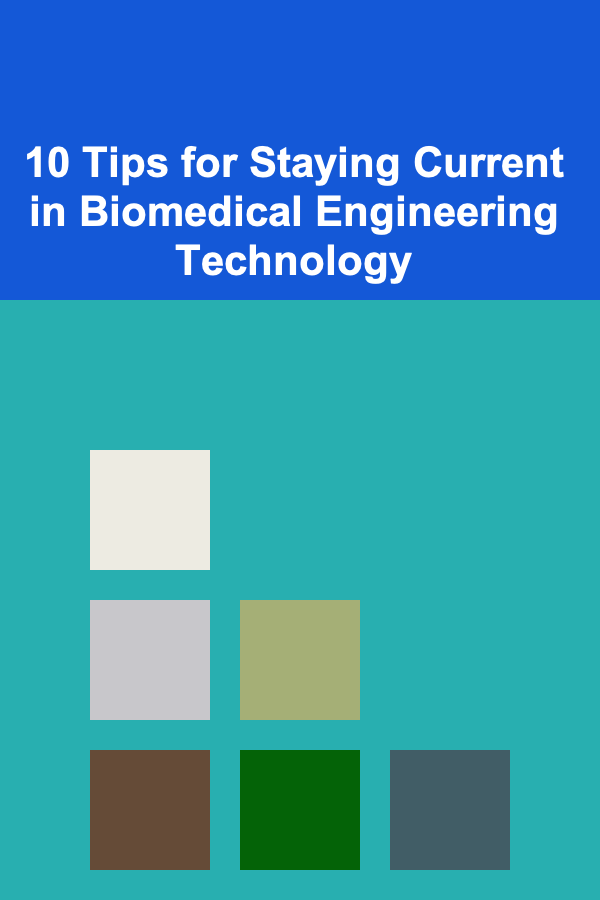
10 Tips for Staying Current in Biomedical Engineering Technology
ebook include PDF & Audio bundle (Micro Guide)
$12.99$10.99
Limited Time Offer! Order within the next:

Biomedical engineering (BME) is an ever-evolving field that combines engineering principles with medical and biological sciences to improve healthcare and medical devices. As technology advances, it's crucial for professionals in biomedical engineering to keep up with the latest trends, techniques, and innovations. Staying current in this dynamic field not only enhances your career but also allows you to contribute effectively to solving complex healthcare problems.
In this article, we'll explore 10 tips to help you stay current in biomedical engineering technology, covering a range of methods from ongoing education to networking and active involvement in the BME community.
Engage in Continuous Education
In the fast-paced world of biomedical engineering, continuous education is key to staying ahead. While a formal degree may have been sufficient in the past, ongoing education is now necessary to keep up with new technologies, medical advancements, and regulatory changes. There are multiple ways to pursue further education:
- Short Courses and Workshops: Many universities, industry groups, and online platforms offer short courses or workshops specifically tailored to the latest biomedical engineering technologies. Topics can include advances in tissue engineering, biocompatible materials, medical device development, and more.
- Online Learning Platforms: Websites like Coursera, edX, and LinkedIn Learning offer courses from top institutions that can help you learn about cutting-edge technologies at your own pace. For example, you could take courses on artificial intelligence in healthcare, machine learning for medical devices, or bioinformatics.
- Graduate Programs: For those serious about deepening their expertise, enrolling in a specialized graduate program can provide the in-depth knowledge needed to keep pace with technological advancements in the field. Specializations like biomaterials, bioinformatics, or medical imaging can broaden your skillset.
Why It Matters: Continuous education helps you stay updated with the latest theoretical and practical advancements in the field, making you more competitive and knowledgeable in your professional practice.
Follow Industry News and Publications
Staying informed about the latest developments in biomedical engineering can be as simple as reading journals, blogs, and news articles. Key industry publications and online platforms provide regular updates on new breakthroughs, regulations, and trends.
- Scientific Journals : Read leading journals such as the Journal of Biomedical Engineering , IEEE Transactions on Biomedical Engineering , and Journal of Biomechanics. These sources publish research on the most recent technological innovations and developments.
- Industry Magazines and Blogs: Websites like MedTech Dive, Bioengineering Today, and Medical Design & Outsourcing offer news, product reviews, and insights into the latest trends in biomedical engineering.
- Newsletters: Subscribe to newsletters from biomedical engineering societies or medical device companies. These often provide updates on the latest conferences, industry reports, and breakthroughs.
Why It Matters: Keeping up with the latest research and developments enables you to understand emerging technologies, industry shifts, and potential opportunities for innovation. It also keeps you well-informed on regulatory changes, which is crucial in the medical field.
Participate in Conferences and Seminars
Attending conferences and seminars is one of the best ways to stay at the forefront of biomedical engineering. These events bring together professionals, researchers, and companies to discuss the latest trends, showcase innovations, and provide networking opportunities.
- Major Conferences : Attend well-established events such as the Annual International Conference of the IEEE Engineering in Medicine and Biology Society (EMBC) , Biomedical Engineering Society (BMES) Annual Meeting , and MEDICA (the world's largest medical trade fair). These conferences cover a wide range of topics in BME, including medical devices, robotics, biomaterials, and regenerative medicine.
- Workshops and Seminars: Many conferences offer specialized workshops where you can get hands-on experience with new technologies and tools. These seminars allow you to ask questions, learn directly from experts, and gain practical knowledge.
- Networking: Conferences provide an excellent opportunity to meet and network with other professionals in the field. This can lead to collaborative projects, job opportunities, or even mentorship.
Why It Matters: Conferences and seminars expose you to the latest research, technologies, and developments in BME. They also offer the chance to collaborate with peers, exchange ideas, and discuss challenges and solutions in real-time.
Network with Peers and Mentors
Networking is an essential aspect of professional development. By engaging with others in the biomedical engineering field, you can learn from their experiences, share your own insights, and stay updated on the latest trends and opportunities.
- Professional Organizations : Join relevant organizations such as the Biomedical Engineering Society (BMES) or the American Institute for Medical and Biological Engineering (AIMBE). These organizations offer opportunities for networking, career advancement, and participation in webinars and discussions.
- Social Media and Online Forums: LinkedIn and Twitter can be valuable tools for connecting with industry experts and following thought leaders in biomedical engineering. Many professionals share their work, ideas, and discussions on these platforms.
- Mentorship: Find a mentor who is an experienced professional in your area of interest within biomedical engineering. A mentor can provide guidance, career advice, and insights into emerging trends.
Why It Matters: Networking fosters a sense of community within the BME field. Mentors and peers can offer support, advice, and introduce you to new resources or opportunities that can help you stay current.
Engage with Emerging Technologies
Biomedical engineering is closely tied to the advancement of technology, and staying current requires understanding how emerging technologies are being applied to healthcare and medical devices.
- Artificial Intelligence (AI) and Machine Learning: AI and machine learning are transforming areas such as medical imaging, diagnostic tools, and personalized medicine. Learning how these technologies are being integrated into BME can give you a competitive edge.
- 3D Printing and Bioprinting: 3D printing is already being used to create custom prosthetics and implants, while bioprinting offers the potential to print tissues and organs. Understanding these technologies and their applications can place you on the cutting edge of BME innovations.
- Wearable Health Devices: The rise of wearable technology, such as smartwatches and health trackers, is revolutionizing patient monitoring and chronic disease management. Keeping up with the development of these devices is crucial for staying current in BME.
Why It Matters: Engaging with emerging technologies helps you anticipate future trends and gives you the knowledge to implement or innovate with these tools in your own work.
Collaborate with Multidisciplinary Teams
Biomedical engineering is inherently multidisciplinary, requiring knowledge from fields such as mechanical engineering, biology, chemistry, and computer science. To stay current, it's crucial to collaborate with experts from these various domains.
- Cross-Disciplinary Collaboration: Work with researchers, healthcare professionals, and technologists in fields like bioinformatics, materials science, and data analytics. These collaborations can help you gain a broader perspective and bring new ideas to your work.
- Interdisciplinary Projects: Many of the most exciting developments in BME come from projects that bridge different disciplines. Participate in research or projects that involve a diverse range of skills and knowledge, such as robotics for surgery, nanotechnology for drug delivery, or bioengineering for regenerative medicine.
Why It Matters: Collaboration with other disciplines allows you to leverage different areas of expertise and discover new ways to apply biomedical engineering principles to healthcare challenges.
Stay Informed About Regulatory Changes
Regulations and standards in the biomedical engineering field are critical, especially since the technologies involved often deal directly with patient safety and health. Keeping up-to-date with regulatory changes ensures that you remain compliant and can predict any impact on your work.
- FDA Guidelines: The U.S. Food and Drug Administration (FDA) regulates medical devices and technologies. Understanding the regulatory pathways for approval (such as 510(k) or Premarket Approval) is essential for engineers involved in product development.
- Global Regulations: If you work in international markets, staying informed about regulations such as CE Marking (European Union) or TGA (Australia) is crucial.
- ISO Standards: Organizations like the International Organization for Standardization (ISO) set important standards in medical device design and testing. Regularly review changes in ISO standards, particularly those related to safety and risk management.
Why It Matters: Staying informed about regulatory guidelines helps you avoid costly delays in product development and ensures that the medical technologies you work on are safe and compliant with the law.
Conduct Research and Innovation
For those actively involved in the technical side of biomedical engineering, conducting research is a powerful way to stay current with new ideas, technologies, and methodologies.
- Focus on Niche Areas: Choose a specific area of biomedical engineering, such as bioelectronics, medical imaging, or implantable devices, and push the boundaries of existing knowledge.
- Collaborate on Academic Research: Partner with academic institutions or research hospitals to participate in clinical studies or laboratory research. This can give you access to cutting-edge technology and innovations.
- Publish Your Work: Writing research papers, attending academic conferences, and publishing your findings can help you stay current in your field and contribute to the advancement of biomedical engineering.
Why It Matters: Research and innovation put you at the forefront of technological developments, allowing you to not only stay current but also contribute directly to the future of the field.
Invest in Professional Development and Certifications
As a biomedical engineer, investing in your professional growth through certifications and skills development is an excellent way to stay competitive and demonstrate your commitment to continuous learning.
- Certifications in Specific Technologies: For example, certifications in medical device design, regulatory affairs, or quality assurance can boost your credentials and expertise.
- Professional Development Programs: Many professional organizations offer structured programs in areas such as leadership, project management, or advanced biomedical technologies. These programs help you develop both technical and soft skills.
Why It Matters: Certifications and professional development demonstrate your dedication to staying at the top of your field and can make you more attractive to employers or collaborators.
Contribute to the BME Community
Active involvement in the biomedical engineering community can offer many benefits, including staying updated on industry trends, gaining new insights, and forging valuable professional relationships.
- Volunteer for Committees: Many BME organizations have committees focused on standards, education, or ethics. Volunteering for these committees can give you a direct role in shaping the direction of the field.
- Join Online Communities: Online forums, LinkedIn groups, and virtual meetups provide an accessible way to engage with peers and share knowledge.
- Mentorship and Teaching: Becoming a mentor or teaching workshops allows you to solidify your knowledge while helping others in the field. Sharing your expertise can keep you engaged and aware of the latest challenges and advancements.
Why It Matters: Contributing to the BME community not only helps you stay current but also enables you to give back to the field, fostering innovation and collaboration among your peers.
Conclusion
Staying current in the biomedical engineering field is a continuous process that requires a combination of education, networking, practical experience, and personal initiative. By actively engaging in lifelong learning, keeping up with industry news, attending events, collaborating with others, and staying involved in the community, you can position yourself as a leader in the rapidly evolving world of biomedical engineering. Through persistence and dedication, you'll be well-equipped to contribute to innovations that improve healthcare and make a tangible impact on the world.
Reading More From Our Other Websites
- [Personal Care Tips 101] How to Make Your Lipstick More Hydrating and Nourishing
- [Personal Financial Planning 101] How to Negotiate and Save Money on Bills: Utilities, Insurance, and More
- [Personal Investment 101] Create Passive Income Streams with Deep Learning and Machine Learning
- [Weaving Tip 101] Best Ways to Create Reversible Weave Patterns for Double‑Sided Table Runners
- [Personal Finance Management 101] How to Automate Your Finances for Easier Management
- [Organization Tip 101] How to Use Signs and Banners for Better Visibility of Your Yard Sale
- [Organization Tip 101] How to Create a Family Command Center in a Small Area
- [Metal Stamping Tip 101] Cost‑Effective Finishing Techniques for High‑Volume Metal Stamping Production
- [Home Lighting 101] How to Choose the Right Light Bulbs for Plant Growth
- [Organization Tip 101] How to Organize Your Music Collection Sustainably

How to Make a Checklist for Seasonal Car Maintenance
Read More
How to Start Investing in Cryptocurrencies Safely
Read More
How to Use Your Old Clothes to Make Money
Read More
How to Make Your Own Healthy Baked Goods
Read More
How To Master Short-Form Video Content
Read More
10 Tips for Holiday Gift Wrapping: A Checklist for Stress-Free Season
Read MoreOther Products

How to Make a Checklist for Seasonal Car Maintenance
Read More
How to Start Investing in Cryptocurrencies Safely
Read More
How to Use Your Old Clothes to Make Money
Read More
How to Make Your Own Healthy Baked Goods
Read More
How To Master Short-Form Video Content
Read More